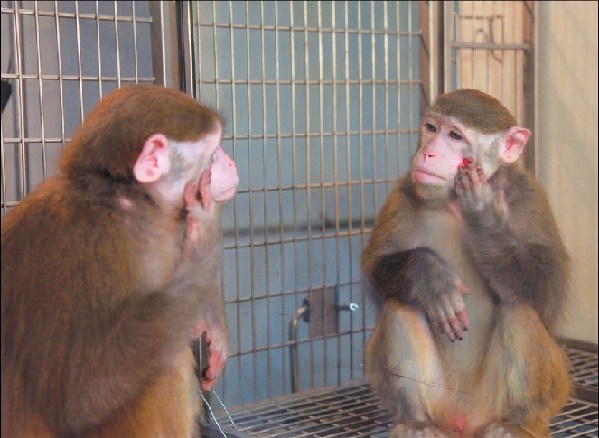Shanghai scientists' monkey mirror breakthrough
 0 Comment(s)
0 Comment(s) Print
Print E-mail Shanghai Daily, January 12, 2015
E-mail Shanghai Daily, January 12, 2015
Monkeys don't instinctively recognize themselves in the mirror but they can learn, according to Shanghai researchers.
 |
|
A monkey touches an area of its face marked by a light spot in self-recognition training at the Shanghai Institutes for Biological Sciences . — Xinhua |
What's more, once monkeys develop mirror self-recognition, they seem to love using mirrors spontaneously to explore parts of their bodies they normally don't see, researchers from the Chinese Academy of Sciences said.
The findings, published in the US journal "Current Biology," may shed light on the neural basis of self-awareness in humans and other animals.
"Our findings suggest that the monkey brain has the basic 'hardware' for mirror self-recognition, but they need appropriate training to acquire the 'software' to achieve self-recognition," said Neng Gong of the Shanghai Institutes for Biological Sciences, part of the Chinese Academy of Sciences.
In earlier studies, scientists had offered monkeys mirrors for years, even beginning at a young age, Gong said.
While the monkeys could learn to use the mirrors as tools for observing other objects, they never showed any signs of self-recognition, he said.
For example, when researchers marked the monkeys' faces and presented them with mirrors, they didn't touch or examine the spot or show any other self-directed behavior.
Gong and his colleagues sat monkeys in front of a mirror and shone a mildly irritating laser light on their faces.
After two to five weeks of training, the monkeys had learned to touch their faces in areas marked by a non-irritant light spot or odorless dye in front of a mirror and by a virtual face mark on the mirroring video image on a screen.
"Five of the seven monkeys in the study showed typical mirror-induced self-directed behaviors, such as touching the mark on the face and then looking and smelling at their fingers as if they were thinking something like, 'Hey, what's that there on my face?'" Gong said. "Furthermore, they spontaneously use the mirrors to explore normally unseen body parts."
The findings may help people unable to recognize themselves in the mirror due to brain disorders such as learning difficulties, autism, schizophrenia or Alzheimer's disease, the team said.
"Although the impairment of self-recognition in patients implies ... cognitive/neurological deficits in self-processing brain mechanisms, our finding raised the possibility that such deficits might be remedied via training," they wrote.






Go to Forum >>0 Comment(s)